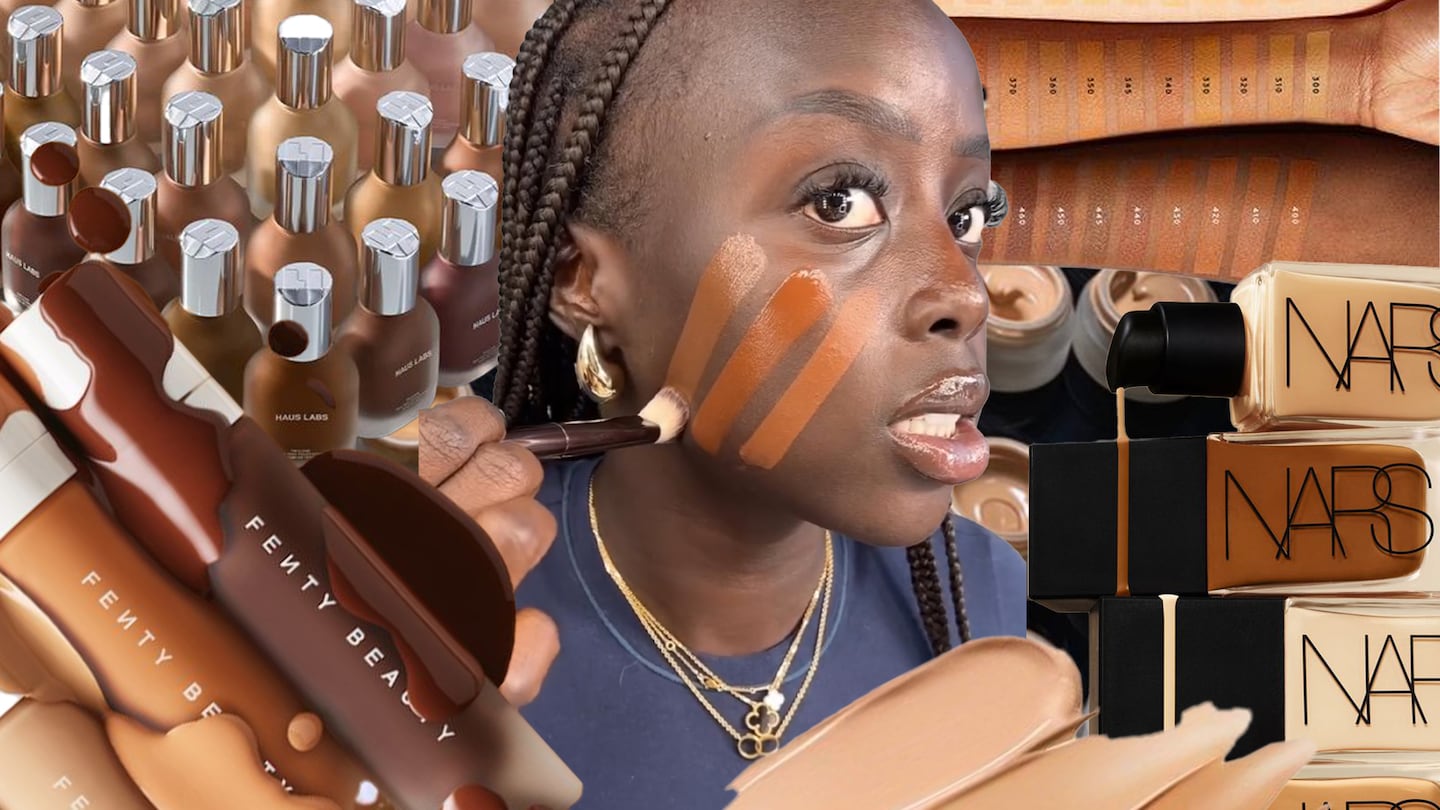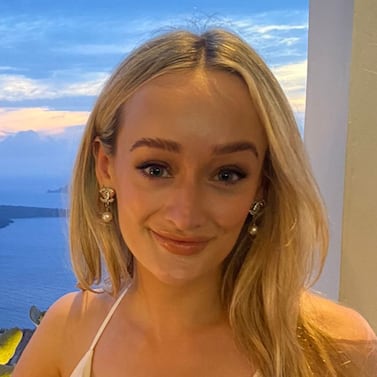
The Business of Fashion
Agenda-setting intelligence, analysis and advice for the global fashion community.

Agenda-setting intelligence, analysis and advice for the global fashion community.

When Golloria George first went viral in 2022, it was for a reason that seemed out of another beauty era: Not being able to find a foundation shade dark enough for her skin tone.
“The lack of shade inclusivity was almost deafening,” George said in an interview with The Business of Beauty of her visit to a Texas drug store to pick up a foundation ahead of a college football game that night. After finding that even the darkest shade was far too light for her skin, she filmed a video about the experience and uploaded it to the platform. “The next morning, it had 20 million views. I realised people still really want to see this kind of content.”
George’s experience came five years after Rihanna’s cosmetics brand, Fenty Beauty, set a new industry standard when it released its Pro Filt’r Foundation in a then-unheard-of 40 shades (it now has 50). Mainstream brands usually carried around half that number.
The launch ignited a global conversation about the lack of options for people with darker skin who had long lacked the rich selection of shades lighter-skinned shoppers had. Brands from CoverGirl to Dior expanded their own shade ranges, and new labels have launched with a wide range from the get-go: Lady Gaga’s Haus Labs brand carries 51 shades, while Ariana Grande’s Rem Beauty has 60. Founder-led indie brands like Danessa Myricks, Pat McGrath and Uoma Beauty have made inclusivity central to their brands’ missions, with 26, 34 and 51 shades, respectively.
ADVERTISEMENT
“When Fenty hit the scene, it was not only a reckoning, it was also a birthing of a new acceptance and conversation at the beauty counter,” said Nyakio Grieco, a serial beauty entrepreneur and co-founder of Thirteen Lune, a retailer dedicated to Black and brown founders.
Still, brands don’t quite seem to have taken the standard Fenty Beauty set as the beginning of a movement for long-term change, and many haven’t heavily invested in developing products for dark-skinned customers. Shade expansion only does so much. Brands at scale could task their product development teams to meet an arbitrary number of shades, but still failed to do enough testing to ensure the shades are actually complimenting darker skin’s undertones and delivering a natural-looking finish.
Meanwhile, other brands haven’t even gone that far. Prada Beauty, which launched in August 2023, has only ten of its 33 foundation shades earmarked as “dark.” On social media, commenters criticised a perceived “jump” in shades from light to dark in Christian Louboutin Beauty’s Teint Fétiche Le Fluid, which offers 30 shades, with not enough options for darker skin tones. (Prada Beauty did not respond to a request for comment; Christian Louboutin Beauty described the range in an email as a “first step” that offers a “wide spectrum of intensity” and said it will be expanded as needed.)
Stalling progress is indicative partially of cost constraints, but also, indifference. Young, cash-strapped brands are looking for any means necessary to save in the current lean financial climate, which squeezes product development. But even larger, better-resourced companies are failing to meet the mark when it comes to diversity commitments – a trend that’s been observed in fashion, too.
For George, all the positive energy from the era immediately following Fenty Beauty’s launch dropped off far too soon. “I just don’t think the beauty industry has perfected complexion in general [for dark skin],” she said.
For small brands, the uncomfortable truth is that the cost of product development can outweigh the desire to create a more diverse shade offering. Esther Olu, a cosmetic chemist who uses the moniker The Melanin Chemist on social media, said that many foundations are made from the same “base” mix of ingredients that gives the product its substance and performance, usually a pure white formula. From there, pigment is added to create different shades.
“Suppliers usually cost that base formula up first, and then there’s further charges for more shades,” said Olu. Sometimes, adding more pigment can increase the cost of a certain shade. Dr. Julian Sass, a cosmetic development specialist, also noted that more shades also increases packaging costs.
Some brands try to hedge their bets by making lighter-coverage products, theoretically stretching the amount of skin tones they can compliment. But Olu said this approach tends to fall flat.
ADVERTISEMENT
“You cannot stretch a foundation that far,” she said.
Foundation is also just one piece of the puzzle. George said that while some brands now make a foundation she can wear, they may not carry a corresponding concealer, bronzer or contour – three more sales they’re missing out on.
For brands in their early stages of development looking to stay lean, launching with a smaller selection might be a more appealing prospect — especially if their market intelligence tells them they over-index with consumers of a certain skin colour.
But Grieco, whose beauty label Relevant: Your Skin Seen launched foundation in November, said shortcuts cost more in the long term, particularly in a world where a negative TikTok video can go viral overnight.
“I understand firsthand how expensive a foray into cosmetics [is]. But you have to be very mindful that nobody wants to feel left out at the counter.”
Racing to add shades rather than investing in truly great shades is still tripping brands up. By adding 30 plus shades, brands may feel they’re reducing the risk of a social media backlash when they announce its launch, but in time, it will cost them, said George.
That’s how darker skinner shoppers can still end up with a seemingly broad range of products, but nothing that’s truly wearable. All skin tones have what’s known as undertones, subtle differences in colour often referred to as cool, warm or neutral that affect the skin’s overall colour. “I think the beauty industry has this misconception that people with darker complexions just always lean more in red undertones,” said George, adding that undertones are one of the main reasons she’s unable to find a suitable shade. She added that it’s obvious to her when a brand hasn’t tested all the shades on the skin tones they’re intended for.
Sass said that when brands don’t cater to all skin tones, they self-segregate. They may not have a large Black customer base when they launch, but if they never try to make inroads, they never will. That’s a huge section of customers to be missing – research from consumer intelligence company NIQ said beauty spending by Black consumers in the US alone rose $1.3 billion in 2023 to a total of $9.4 billion.
ADVERTISEMENT
Grieco and Olu said that if brands can only afford to make a limited number of shades, they should still distribute from light to dark. Brands should also be proactive when it comes to naming shades, to give themselves future flexibility. Sass recalled a tinted sunscreen that launched with numbered shades, and how that came to limit them.
“When they finally added more shades for darker tones, they had to call them 9.5, 10.25,” Sass said. “It’ll always be obvious those shades were an afterthought.”
If brands know they’ve not delivered enough choice before, all is not lost, both Sass and George said. Brands — especially those that are founder-led — should own up to their mistake and put in the time and investment to expand the offering. Plus, be aware that it may take some time to recruit Black customers.
Indie brand Youthforia, for example, found itself facing online backlash after the launch of its Date Night Foundation in October, releasing only two out of 15 dark shades, with three “medium to deep” hues. In an initial response on TikTok, founder Fiona Co Chan said that the launch was intended as “proof of concept”, and that they planned to add more shades once they were sure the formula was right. In an email to The Business of Beauty, the brand said feedback was “really important” and while working to add ten more shades, it had also hosted a listening session with diversity platform Black Beauty Roster where the company worked with creators, makeup artists and activists to “learn and implement action towards inclusivity.” The brand also said it’s “encouraged by the positive response from the Black community [sic]” who have tested the new shades.
George also said that beauty labels need to be transparent about their offering, even if it isn’t as comprehensive as it should be. Brands shouldn’t be tempted to alter images on their websites to suggest that a foundation is working for a dark-skinned model if it wasn’t a good match in real life, nor should they employ frosted bottles which can make it more difficult for shoppers to shade match.
“If you’re not thinking about how in a decade and a half that the world will be mostly a multicultural consumer, especially here in the US, it’s just a terrible business move,” said Grieco.
E.l.f.’s $355 million acquisition of Naturium doesn’t change the fact that most influencer, actor and musician-fronted brands need to radically rethink their approach.
The event is the latest of the retailer’s initiatives to support founders of colour.

Daniela Morosini is a Beauty Correspondent at The Business of Beauty at BoF. She covers the global beauty industry, with an interest in how companies go to market and overcome hurdles.
How not to look tired? Make money.
In a rare video this week, the mega-singer responded to sceptics and gave the public a look at what her beauty founder personality might be.
Request your invitation to attend our annual gathering for leaders shaping the global beauty and wellness industry.
Excitement for its IPO is building, but in order to realise its ambitions, more acquisitions and operational expenses might be required.